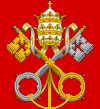 Reform Unitarianism feels a particularly close kinship with the Roman Catholic Church, despite that it is the institution that adopted the apostasy of Trinitarianism. Roman Catholicism retains the sense of the ancient pedigree of Christianity, which more recent off-shoots (which nevertheless imagine themselves reformatory) fail to project.
Reform Unitarianism feels a particularly close kinship with the Roman Catholic Church, despite that it is the institution that adopted the apostasy of Trinitarianism. Roman Catholicism retains the sense of the ancient pedigree of Christianity, which more recent off-shoots (which nevertheless imagine themselves reformatory) fail to project.
This is why it pains us to witness the perennial sex abuse scandals in the Roman Catholic Church, now even shaking the Throne of St. Peter. Only a few are calling for Pope Benedict XVI to resign, but many more are questioning the Church’s policies on clerical celibacy.
For Reform Unitarians — who accept both the marriage of priests and ordination of women — it is clear that the Vatican’s sex-related troubles stem from the same 4th Century political intrigues that pinned the Church to Imperial power and the conflationist theology that eventually became Trinitarianism.
Historical Background
Totalitarianism, Trinity, & Celibacy
Early Church Unitarians* were particularly opposed to celibacy, and this opposition can be seen as part of a larger struggle between the original Christian Church and corruptions arising in Rome and Alexandria that pushed the Church toward a more unforgiving, anti-rational, dictatorial, hostile, and sexually repressive culture.
The earliest push for an official policy of clerical celibacy was by the notorious Bishop Hosius of Córdoba, who had ties to Alexandria and Rome. Hosius was one of the key organizers of the Synod of Elvira (c. 303 AD) which encouraged authoritarian episcopal rule, refusal to forgive lapsed Christians, hostility toward other religions, and clerical celibacy.
Hosius was also a chief instigator of Emperor Constantine’s Council of Nicaea (325 AD) where less than a one-fifth minority of bishops attempted to impose a conflationist dogma on the rest of Christianity, controlling the debate through intimidation and even outright violence.
Nicene dogma soon resulted in the establishment of full-blown Trinitarian conflationism at the Council of Constantinople (381 AD) and the authoritarian Edict of Thessalonica which made Trinitarianism and the authority of the Bishops of Rome and Alexandria a matter of Imperial law. Violators of the Edict (all non-Christians and non-Nicene Christians) would be subject to whatever punishment the Emperors “shall decide to inflict.”
This Edict was followed by a rampage of attacks on pagans and other non-Trinitarians, including the destruction of temples, violent sectarian riots, the forcible disbanding of ancient religious institutions, and the cessation of the Olympic games.
This brand of violently repressive state-church authority is arguably what gave rise to all of the Crusades and Inquisitions that were to follow, the bloody history of which continues to stain the reputation of Christianity.
Moving Forward By Looking Back
So, the sexual abuse of children by celibate priests is only the latest atrocity in the legacy of Hosius and his co-conspirators in the 4th Century. The Papacy has ceded its Imperial authority to impose church law (outside the confines of the Vatican itself), and has made great strides against the themes of unforgiveness and sectarian hatred.
Now, the corruption of clerical celibacy seems on the verge of reform. The Church already allows converted priests to remain married, and the worldwide sex abuse scandal may be stripping away the final veneer of sanctity for this ancient error.
Much good has been done by the Church of Rome, which is renowned for its charitable and humanitarian efforts. Even arch-atheist Christopher Hitchens has had good words to say about Pope John Paul II, if not for the institution he led.
Indeed, Trinitarian churches in general can be great forces for justice and morality; the Reverend Martin Luther King Jr., for example, was a Trinitarian.
But, like someone whose coat-tail has been caught on a nail, Trinitarian Christianity must look back in order to move forward, freeing itself from the un-Christian snags of the 4th Century.
Authoritarianism, religious bigotry, clerical celibacy, and unforgiveness are certainly chief among the spawn of that dark century, but the anti-rational and un-Scriptural heart of this multi-headed dragon is the anti-Christ, conflationist theology known as Trinitarianism.
_
* Often mislabelled “Arians,” as if their theology was invented by its ablest defender Bishop Arius of Africa, in a crude but effective attempt to discredit what was in reality a broad consensus in the Early Church. This dirty political trick continues to be used today, for example by those trying to diminish the broad consensus in climate science by labelling it “what Al Gore thinks,” or to dismiss centuries of rigorous biblical scholarship as “Bart Ehrman’s opinion.”
